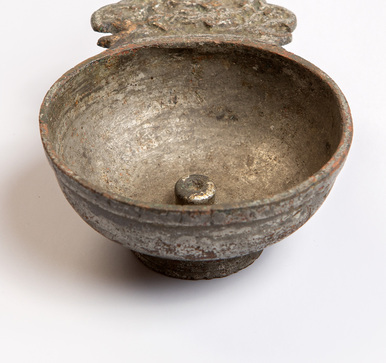Crosses are among the most numerous archaeological finds and illustrate the culture of Old Rus. Researchers usually found such objects during excavations of cities, rural settlements and mounds with things that could be dated to the 11th and 12th centuries. Pectoral crosses stand out among the finds.
Most often, this type of religious symbols in the pre-Mongol era was decorated with patterns. One of them, presumably of Byzantine origin, was an indented circle, which was considered a protective symbol. This pattern can be seen on the cross displayed in the exhibition of the Museum “The Smolensk Fortress”.
Enamel crosses are a common find. It is believed that the use of this method of decorating objects came to Rus from Byzantium. However, this was more the case of cloisonné enamel.
Historians believe that Russian artisans switched to the technology of simpler champlevé enamel in order to reduce the cost of the product and make it more mass-produced and affordable. They made grooves in the metal base and then filled it with a glass-like coating. Kyiv was the center of production of such crosses.
Gradually, artisans from other cities adopted this technology. Presumably, small objects with champlevé enamel was created in Chernigov, Vladimir, Ryazan, and Novgorod. After the defeat of Kyiv by the Mongol-Tatars, the production of such products in this city stopped. However, champlevé enamel existed in the territory of northeastern Rus even in the 14th century.
There are 40 known types of crosses with different colors of enamel. The most popular color for decorating these items was yellow, perhaps because it symbolized the sun. The museum exhibition includes a cross, which belongs to the type of round-ended ones with flaring arms and paired protrusions at the ends. The cross is double sided. The round recesses were filled with yellow enamel, while the rectangular ones were filled with red. In the upper part, the craftsman made a flat suspension loop.
Most often, this type of religious symbols in the pre-Mongol era was decorated with patterns. One of them, presumably of Byzantine origin, was an indented circle, which was considered a protective symbol. This pattern can be seen on the cross displayed in the exhibition of the Museum “The Smolensk Fortress”.
Enamel crosses are a common find. It is believed that the use of this method of decorating objects came to Rus from Byzantium. However, this was more the case of cloisonné enamel.
Historians believe that Russian artisans switched to the technology of simpler champlevé enamel in order to reduce the cost of the product and make it more mass-produced and affordable. They made grooves in the metal base and then filled it with a glass-like coating. Kyiv was the center of production of such crosses.
Gradually, artisans from other cities adopted this technology. Presumably, small objects with champlevé enamel was created in Chernigov, Vladimir, Ryazan, and Novgorod. After the defeat of Kyiv by the Mongol-Tatars, the production of such products in this city stopped. However, champlevé enamel existed in the territory of northeastern Rus even in the 14th century.
There are 40 known types of crosses with different colors of enamel. The most popular color for decorating these items was yellow, perhaps because it symbolized the sun. The museum exhibition includes a cross, which belongs to the type of round-ended ones with flaring arms and paired protrusions at the ends. The cross is double sided. The round recesses were filled with yellow enamel, while the rectangular ones were filled with red. In the upper part, the craftsman made a flat suspension loop.



